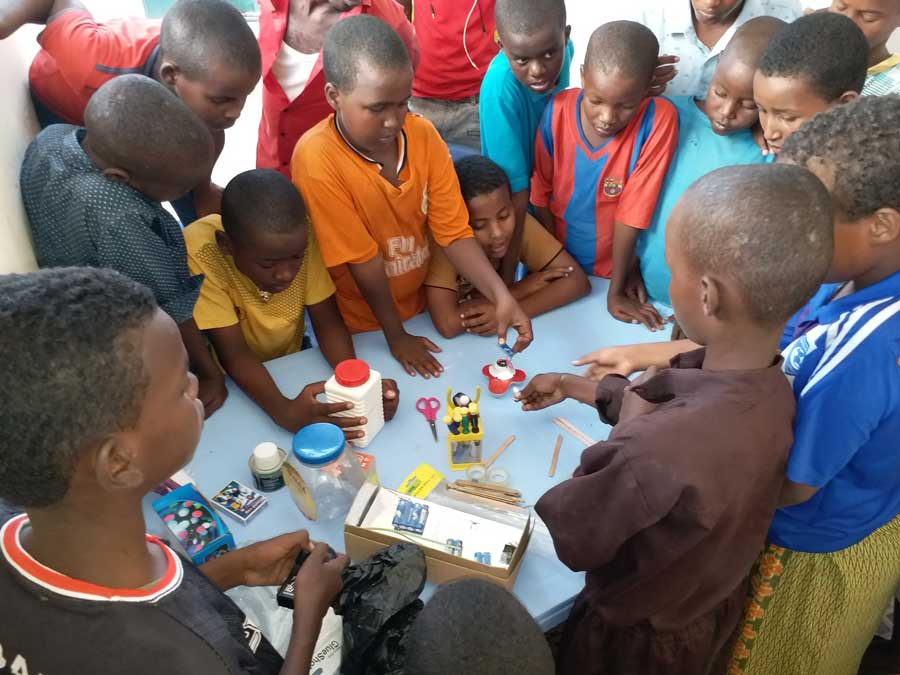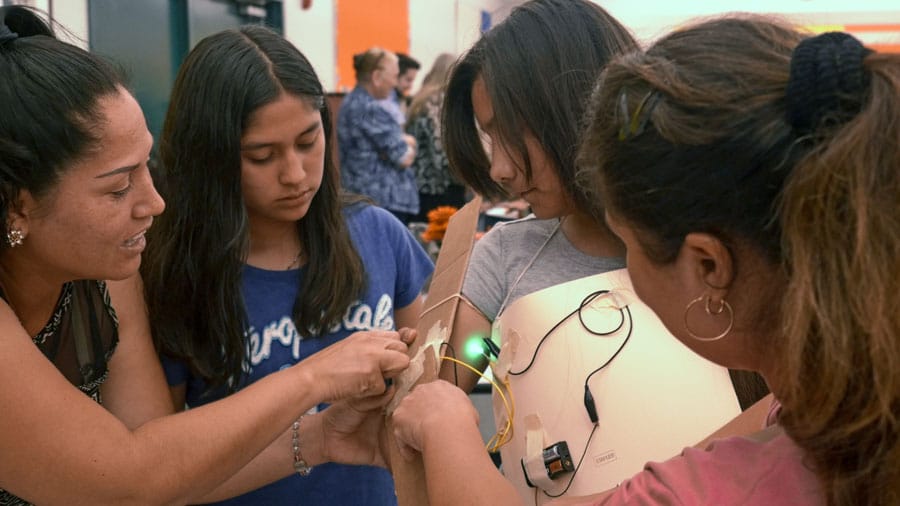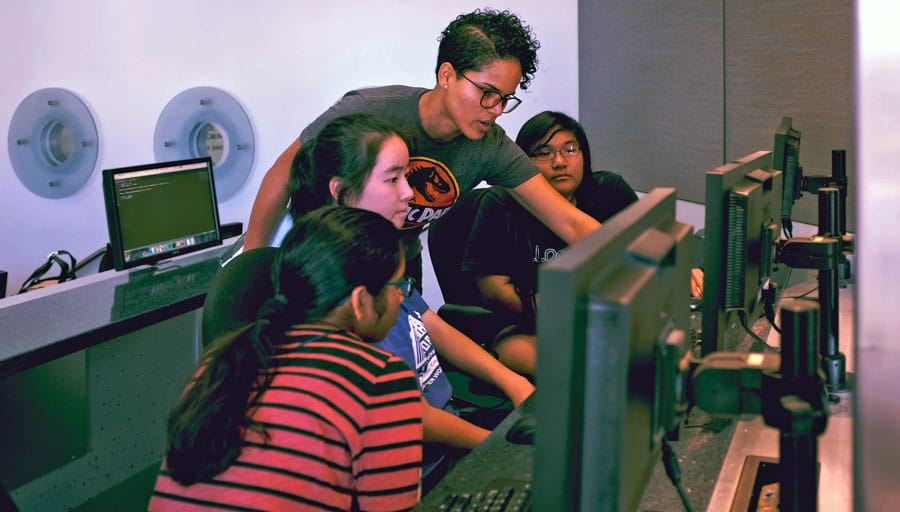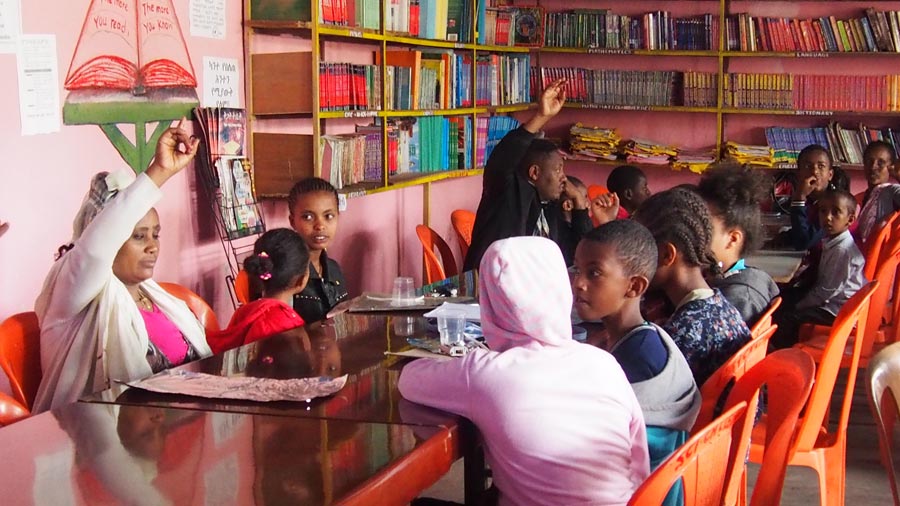Iridescent: Disrupting the classroom for the better
The education system has struggled to keep up with the constant evolution of technology. Iridescent, a global non-profit organisation, is revolutionising education by providing programmes that empower underserved children through technology and engineering. With a special focus on underrepresented young girls, Iridescent challenges the negative myths surrounding AI and uses technology to inspire children to become innovators. Research Outreach spoke with founder and CEO Tara Chklovski of global non-profit Iridescent, discussing how Iridescent’s goals have become a reality.
It is crucial that children have the technological knowledge and understanding to succeed in today’s digital world. Unfortunately, many education systems are insufficient in preparing children for the workforce, especially those from underprivileged upbringings. Iridescent has identified the necessity to incorporate STEM education, technology and AI into children’s lives at an early stage through cutting-edge programmes and technology. Through these methods, Iridescent hopes to inspire the next generation to become innovators.
Iridescent has experienced incredible growth since its inception in 2006; the non-profit now has a global reach. Iridescent’s success is attributable to its clear strategy, its collaboration with industry experts and its ability to stay abreast of technological evolution.


Hi Tara! Can you tell us more about Iridescent in terms of its background, history and core mission?
Iridescent is a global non-profit organisation that provides cutting-edge STEM education to underserved children, and their families through two programmes; Technovation and Curiosity Machine. We use technology-based and engineering-based programmes to achieve the aim of empowering the world’s underrepresented young people (especially girls) to become innovators and leaders.
Our organisation was founded in 2006 from a desire to help the education system, a system that is often slower to evolve in the rapidly changing technology industry. Since Iridescent’s founding, the non-profit has grown tremendously; we now operate in more than 115 countries and deliver STEM curriculum to more than 100,000 children and their families worldwide. Iridescent is proud to be the first organisation to assist young girls in underserved communities learn coding and app development skills through our Technovation Challenge. The Technovation Challenge programme introduces the girls to technological concepts in an engaging way. We recently introduced the Artificial Intelligence (AI) Family Challenge as a new part of our popular Curiosity Machine programme.
Tell us about your journey into Artificial Intelligence? What led you to launch an AI-focused programme?
For 12 years, we have been introducing children worldwide to cool new technologies and scientific advances including nanotechnology, mobile computing and robotics. We are attuned to technological trends as well as being skilled at identifying new skillsets which children, and their parents, will need in order to compete and succeed in today’s evolving workforce. The renowned fear surrounding Artificial Intelligence (AI) made AI a natural next step for our programmes and curriculum. AI is rapidly changing our world and the nature of people’s work. The primary and secondary education systems are not equipped with the knowledge, information or resources to respond quickly enough to prepare children, or even adults, for the workforce. It is this problem that Iridescent is working to solve.

We established the Artificial Intelligence (AI) Family Challenge with the goal to empower and equip children from underserved communities with the necessary knowledge to play a key role in innovation. Our goal is to show children that this field is accessible and that they can play a pivotal role in the industry from the onset. Another of our aims is to show these children that the innovation field is a viable and fulfilling career path.
What was Iridescent’s impact in 2017 and goals for this year? Is Iridescent on the right track to completing the goals set in the 2015-2019 strategic plan and Theory of Change?
In 2017 alone we reached five of the six goals outlined in our 2015-2019 strategic plan. Notably, we increased participant reach nearly 40% to 35,000 annual programme participants, and we partnered with 7,000+ organisations worldwide. We were very proud of effectively scaling for participant and partner growth whilst simultaneously decreasing our average costs to $10/contact hour.
Our organisational growth and increased global reach in 2017 demonstrate that families, community partners, and corporate funders continue to turn to Iridescent as both a provider and partner. Stakeholders such as these trust Iridescent in delivering high-quality STEM education programmes that not only teach but also excite underserved youth.
In 2018 we are making greater strides towards our 2015-2019 strategic plan. We are taking steps that will help us measure, as well as share, the impact of our programmes on participants, mentors, partners, and educators more effectively. Furthermore, we have committed to increasing our transparency in our impact reporting.
Our proudest achievement in 2018 was the launch of the AI Family Challenge. The programme received a wonderful response from families, educators, professionals, and funders.
Our two primary programmes, Technovation and Curiosity Machine, introduce underserved communities to cuttingedge technologies.
Can you tell us more about the two programmes Curiosity Machine and Technovation? What impact have they had so far?
Our two primary programmes, Technovation and Curiosity Machine, introduce underserved communities to cutting-edge technologies. Through our detailed, yet accessible curriculum, we equip and empower kids, their families, and those mentoring or coaching them to apply the knowledge they have learned to solve real-world problems.
This year we launched our a new initiative, the Artificial Intelligence (AI) Family Challenge. The curriculum teaches children ages 8-15, and their parents about AI technologies. Families are guided through the process of creating an AI-based product that solves problems that face society including transportation, health, the environment and education.
Engineering and AI-knowledgeable mentors support participating families. These mentors are rigorously trained to ensure participants have a positive experience that is both informative and engaging.

Technovation Challenge encourages entrepreneurship in girls (aged 13-18) by challenging them to identify a problem in their community. The girls are then tasked with developing a mobile app and a start-up business that solves the identified problem. The girls collaborate with mentors to learn the skills necessary to bring their idea to life.
Our cutting-edge curricula, teaching strategies, lesson plans, and mentor training materials for both programmes are freely available to educators, parents and mentors worldwide.
What has your research shown on how have these programmes failed and succeeded?
We have found that gathering and evaluating insights from our programme participants, mentors and educators are critical to understanding our programmes’ effectiveness. The evaluation process has also helped us to identify ways to improve and enhance our programmes. We have learned many things across our programmes, most notably we’ve discovered:
- Children report having a better understanding of science and engineering (74.8%) and are more interested in science at school (74.8%);
- Parents report having a better understanding of science and engineering (77.8%) and that they will read more science books with their children (88.9%); and
- College-level student instructors reported learning practical skills like critical thinking, creativity, public speaking, and collaboration.
We are excited about the impact our programmes have on our audiences. We are committed to applying a data-driven approach to continually improve our operations. Our aim is to ensure that we consistently deliver interesting and relevant information that is both educational and engaging.
Our aim is to ensure that we consistently deliver interesting and relevant information that is both educational and engaging.
Iridescent has some very well-known supporters and partners – why are they so important to Iridescent’s success?
We are incredibly fortunate to have a wide variety of partners who are as passionate about our mission to bring STEM education to underserved children and families through Iridescent. While our corporate partnerships take many forms, we have found some of the best relationships are designed around skills-based volunteering opportunities. Through these types of partnerships, corporations encourage tech-savvy employees to share their knowledge by educating youth about topics ranging from self-driving cars, to robotics and biomechanics. These mentors play a crucial role in helping families learn about complex technology concepts in engaging and accessible ways. We’ve also found that this method of volunteering is a powerful tool to help engineering companies retain employees, particularly women.
What are the major challenges in making AI more accessible to local communities? How do you overcome these challenges?
There are multiple factors that impact people’s acceptance of AI. People’s perceptions differ and views can range from confusion about what AI is, how AI can fit into our daily lives and how AI will disrupt the workforce. There is fear that AI will take away many jobs, especially in underserved communities. We often talk to parents who are concerned about how they can provide their children with the necessary tools and skills to succeed in today’s digital world.
For underserved families, in particular, there is often limited access to STEM education beyond what they find in the classroom. In fact, according to a recent study we commissioned, only 36% of children receive technology education outside of their schooling. We want to help children and their parents feel confident and optimistic about their family’s future in a world filled with new technologies. We aim to build their confidence by giving families a hands-on experience with AI to demystify the technology and remove the negative perceptions around it.

How can scientists and engineers get involved with your programs and outreach?
There are many ways scientists and engineers can involve themselves in our programmes either individually, or through their employer. We regularly work with technology professionals to invent challenges for students based on the professional’s line of work. This could include anything from driverless cars to robotics.
Another method we use is encouraging professionals to share their story via video such as teaching families about a topic within their area of expertise or to inspire children and families to tackle challenges within our programs.
Professionals can also make a difference by acting as mentors, either online or within the community. Mentors often express to us that their mentoring not only changes a child’s life but also can have a transformative effect on their own life. For example, the experience can teach the mentor how to communicate complex concepts more effectively whilst working in their own professional capacity.
Iridescent is a 501(c)3 registered non-profit organisation, and you clearly value transparency by openly publishing your financial documents on your website – has this received a positive reaction?
We believe transparency is very important and we consistently receive positive reactions across all our stakeholders for our openness. In fact, for 2018, we changed our reporting policies so that we are now analysing and sharing our key learnings and programmes impact data on a quarterly basis.
What does the future hold for Iridescent? Where do you see Iridescent in the next five years?
We are always evaluating new technology trends and identifying ways to connect underserved families with industry experts who are changing the ways we live, work and play. One of the fields we observe very closely is the world of gaming. The gaming world is usually ahead of many other industries in multiple ways. We are curious about how Virtual Reality combined with AI will result in unique learning journeys for students. Iridescent has the potential to completely disrupt learning as we know it.
In five years, I hope Iridescent will be the leader in AI-education for both children and parents. Iridescent will continue to introduce collaborative platforms to families worldwide. Through our platform, families can create disruptive products while embarking on exciting learning journeys in technology.
- To find out more about Iridescent’s mission and their programmes to help young people develop, please visit their website at http://iridescentlearning.org